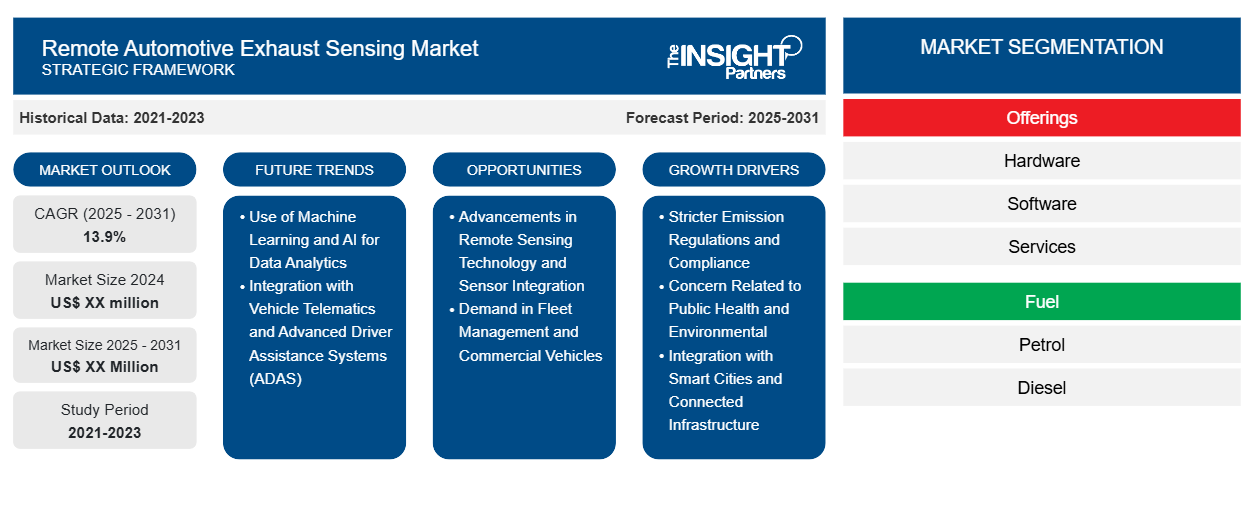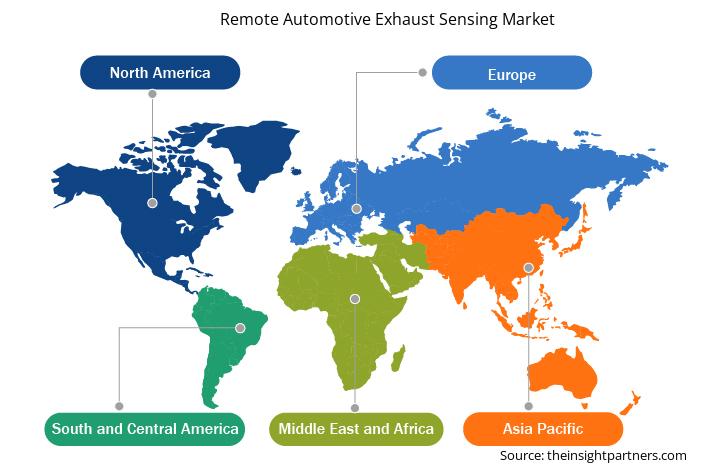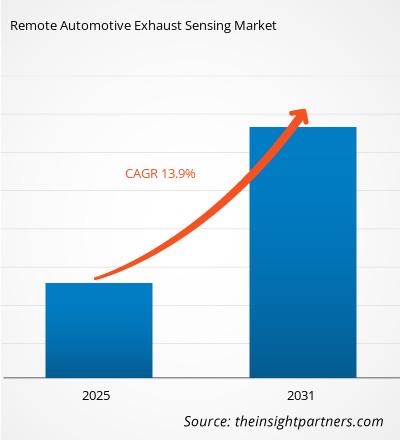预计远程汽车尾气传感市场在 2025 年至 2031 年期间的复合年增长率为 13.9%,市场规模将从 2024 年的 XX 百万美元扩大到 2031 年的 XX 百万美元。
报告按产品(硬件、软件、服务);燃料(汽油、柴油);污染物(一氧化碳 (CO)、二氧化碳 (CO2)、氮氧化物 (NOx)、其他)进行细分。报告以美元为单位,对上述分析和细分市场进行了估值。
报告目的
Insight Partners 发布的《远程汽车尾气传感市场》报告旨在描述该市场的现状和未来增长趋势、主要驱动因素、挑战和机遇。该报告将为各业务利益相关者提供洞见,例如:
- 技术提供商/制造商:了解不断变化的市场动态并了解潜在的增长机会,使他们能够做出明智的战略决策。
- 投资者:对市场增长率、市场财务预测以及整个价值链中存在的机会进行全面的趋势分析。
- 监管机构:规范市场政策和警察活动,旨在最大限度地减少滥用行为,维护投资者的信任和信心,维护市场的完整性和稳定性。
远程汽车尾气传感市场细分
祭品
- 硬件
- 软件
- 服务
燃料
- 汽油
- 柴油机
污染物
- 一氧化碳
- 二氧化碳
- 氮氧化物
地理
- 北美
- 欧洲
- 亚太地区
- 中东和非洲
- 南美洲和中美洲
定制此报告以满足您的要求
您可以免费定制任何报告,包括本报告的部分内容、国家级分析、Excel 数据包,以及为初创企业和大学提供优惠和折扣
远程汽车尾气传感市场:战略洞察

- 获取此报告的主要市场趋势。此免费样品将包括数据分析,从市场趋势到估计和预测。
远程汽车尾气传感市场的增长动力
- 更严格的排放法规与合规性:世界各国政府正在实施更严格的车辆排放法规,以应对空气污染并实现环保目标。例如,欧洲的欧6标准和美国的EPA法规要求车辆达到一氧化碳(CO)、氮氧化物(NOx)和颗粒物(PM)排放的特定阈值。这些法规要求对车辆排放进行更精确的实时监测,从而推动了对先进远程尾气传感技术的需求。传统的尾气排放测量方法通常需要固定装置或直接接触车辆的排气系统。然而,远程传感技术能够进行持续监测,无需与车辆直接互动,使监管机构和环保机构更容易确保合规性。
- 公众健康和环境相关关注:人们日益意识到车辆尾气排放对公众健康和环境的有害影响,这是市场发展的重要驱动力。车辆尾气排放是城市空气污染的主要来源,会导致呼吸系统疾病、心血管疾病和气候变化等问题。各国政府和环保组织面临着越来越大的压力,需要减少排放到大气中的污染物水平。遥感技术提供了一种便捷的解决方案,可以持续监测和控制车辆排放,有助于解决日益严重的环境和健康问题。这反过来又推动了对更广泛应用远程汽车尾气传感技术的需求。
- 与智慧城市和互联基础设施的融合:随着世界各地的城市向智慧城市转型,物联网技术与互联基础设施的融合为远程汽车尾气传感带来了巨大的机遇。在智慧城市中,实时交通监控和环境传感器的集成度日益提高,有助于管理城市污染并优化交通流量。远程尾气传感系统可以与这一更广泛的生态系统相融合,从而实现城市地区和污染热点地区的实时空气质量监测。这种融合将使相关部门能够持续监测车辆排放,并更有效地执行环境标准。此外,随着城市道路网络的互联程度不断提高,尾气传感器可以为城市规划者和决策者提供数据,以优化交通模式、识别高污染区域并及时采取纠正措施来减少排放。
远程汽车尾气传感市场未来趋势
- 机器学习和人工智能在数据分析中的应用:机器学习 (ML) 和人工智能 (AI) 与遥感技术的结合正成为汽车排放市场的重要趋势。人工智能算法可以处理远程尾气传感器收集的海量数据,从而识别趋势、优化车辆性能并预测潜在的排放相关问题。这些技术能够实现预测性维护,帮助在车辆排放系统出现故障或低效之前发现它们,避免造成重大问题或罚款。此外,人工智能驱动的分析技术可用于优化车队管理,实时监测多辆车辆的排放水平,并做出数据驱动的决策,从而提高效率和可持续性。
- 与车辆远程信息处理和高级驾驶辅助系统 (ADAS) 集成:远程尾气传感系统与车辆远程信息处理和高级驾驶辅助系统 (ADAS) 的集成正日益成为一种趋势。通过将尾气传感数据与跟踪车辆位置、速度和燃油效率的远程信息处理系统相结合,操作员可以更全面地了解车辆性能和环境影响。这种集成还支持实时诊断和远程排放监控,为驾驶员和车队管理人员提供有关排放系统状态的即时反馈。此外,在 ADAS 环境中,尾气传感器可以与其他传感器(例如用于空气质量监测的传感器)进行补充,通过向驾驶员提供反馈或引导他们前往污染较少的区域,从而帮助创造更安全、更可持续的驾驶环境。
远程汽车尾气传感市场机遇
- 遥感技术和传感器集成的进步:先进传感器技术的发展是远程汽车尾气传感市场增长的主要驱动力。光学传感、红外光谱和激光测量技术的创新使得非侵入式检测车辆尾气中的有害气体成为可能。这些传感器可以远距离测量排放,在不中断车辆运行的情况下提供准确的数据。此外,物联网 (IoT) 技术与尾气传感系统的集成实现了实时数据收集、远程诊断和持续排放监测,进一步增强了其在车队管理、法规遵从和环境监测方面的实用性。随着这些技术日益先进且经济高效,它们为车辆排放监测提供了可扩展的解决方案,使其日益普及。
- 车队管理和商用车需求:车队管理领域为远程汽车尾气传感技术带来了巨大的发展机遇。车队运营商和物流公司面临着越来越大的压力,需要遵守严格的环境法规并减少运营过程中的碳足迹。远程尾气传感技术可以帮助车队管理人员实时监控多辆车辆的排放,无需现场检查或人工检查。通过实施远程传感技术,车队可以确保遵守法规,优化车辆性能,并降低与排放罚款或发动机效率低下相关的运营成本。此外,该技术还可以通过及早发现潜在的排放控制系统故障,从而增强车辆维护,优化燃油效率,并有助于实现可持续发展目标。
远程汽车尾气传感市场区域洞察
Insight Partners 的分析师已详尽阐述了预测期内影响远程汽车尾气传感市场的区域趋势和因素。本节还讨论了北美、欧洲、亚太地区、中东和非洲以及南美和中美洲的远程汽车尾气传感市场细分和地域分布。

- 获取远程汽车尾气传感市场的区域特定数据
远程汽车尾气传感市场报告范围
| 报告属性 | 细节 |
|---|---|
| 2024年的市场规模 | XX百万美元 |
| 2031年的市场规模 | XX百万美元 |
| 全球复合年增长率(2025-2031) | 13.9% |
| 史料 | 2021-2023 |
| 预测期 | 2025-2031 |
| 涵盖的领域 | 按奉献
|
| 覆盖地区和国家 | 北美
|
| 市场领导者和主要公司简介 |
|
远程汽车尾气传感市场参与者密度:了解其对业务动态的影响
远程汽车尾气传感市场正在快速增长,这得益于终端用户需求的不断增长,而这些需求的驱动因素包括消费者偏好的演变、技术进步以及对产品优势的认知度的提升。随着需求的增长,企业正在扩展产品线,不断创新以满足消费者需求,并抓住新兴趋势,从而进一步推动市场增长。
市场参与者密度是指特定市场或行业内企业或公司的分布情况。它表明特定市场空间内竞争对手(市场参与者)的数量相对于其规模或总市值而言。
在远程汽车尾气传感市场运营的主要公司有:
- 奥普斯集团
- 海格环境与大气技术公司
- 多普勒环保科技有限公司
- 安徽宝龙环保科技有限公司
- 韩国环境公社
- 杭州春来科技有限公司
免责声明:以上列出的公司没有按照任何特定顺序排列。

- 获取远程汽车尾气传感市场主要参与者的概述
主要卖点
- 全面覆盖:该报告全面涵盖了远程汽车尾气传感市场的产品、服务、类型和最终用户的分析,提供了整体概况。
- 专家分析:本报告基于对行业专家和分析师的深入了解而编写。
- 最新信息:该报告涵盖了最新信息和数据趋势,确保了业务相关性。
- 定制选项:此报告可以定制以满足特定客户要求并适合业务策略。
因此,远程汽车尾气传感市场研究报告有助于引领解读和理解行业现状及增长前景。尽管存在一些合理的担忧,但本报告的总体优势往往大于劣势。
- 历史分析(2 年)、基准年、预测(7 年)及复合年增长率
- PEST和SWOT分析
- 市场规模、价值/数量 - 全球、区域、国家
- 行业和竞争格局
- Excel 数据集
近期报告
客户评价
购买理由
- 明智的决策
- 了解市场动态
- 竞争分析
- 客户洞察
- 市场预测
- 风险规避
- 战略规划
- 投资论证
- 识别新兴市场
- 优化营销策略
- 提升运营效率
- 顺应监管趋势






















 获取免费样品 - 远程汽车尾气传感市场
获取免费样品 - 远程汽车尾气传感市场